GREEN CAPITALISM TURNS BROWN AS CANNABIS CAPITALISM COLLAPSES IN CANADA
More pain in store for Canadian marijuana companies after Aurora Cannabis, Tilray cut jobs
TORONTO (Reuters) - Investors are bracing for more job cuts and writedowns at Canadian cannabis producers before the industry stabilizes and becomes profitable, after two of the biggest weed companies, Aurora Cannabis (ACB.TO) and Tilray (TLRY.O) announced cost reductions this week.
FILE PHOTO: Cannabis plants grow inside the Tilray factory hothouse in Cantanhede, Portugal April 24, 2019. REUTERS/Rafael Marchante/File Photo
Canada legalized recreational cannabis in October 2018 but profits have proven elusive for most marijuana companies as fewer-than-expected retail stores, higher prices than on the black market and slow overseas growth resulted in oversupply.
“The Aurora story will be much more common in 2020,” said Hap Sneddon, founder and chief portfolio manager at Castlemoore. “I don’t see rationalization. I see companies leaving the business.”
Many producers, including Canopy Growth (WEED.TO) (CGC.N), Aurora, Tilray and Aphria (APHA.TO) rapidly expanded at home and overseas as capital flooded into the industry before legalization.
Aurora announced a writedown on Thursday of as much as C$1 billion, 500 job cuts and the departure of its chief executive. Tilray said on Tuesday it cut 10% of its workforce, or about 140 jobs.
Lack of profitability is common in new industries, but a prolonged period of higher cash burn unnerves investors.
Aurora must almost quadruple quarterly sales to meet expenses and Tilray nearly double them, according to Reuters and Infor Financial calculations, based on their latest quarterly results, before they announced the cuts.
An Aurora spokeswoman said the company was making “aggressive changes” because its previous cost structure was “misaligned with the current market conditions”. The cuts and existing financing will cover costs until it sees profits, she said.
Tilray, which says it expects profits by the end of fiscal 2020, will bridge the gap with debt until then, a spokeswoman for that company said.
Short sellers made more than $60 million in paper profits on Friday from a fall in Aurora’s Canadian and U.S. shares, according to S3 Partners, a financial analytics firm. Aurora is the third most shorted pot stock tracked by S3 Partners, trailing Canopy and GW Pharma (GWPH.O).
The Horizons Marijuana Life Sciences ETF (HMMJ.TO) has lost 68% since its Oct. 16, 2018 peak.
While the sector could see some consolidation, the shareholder dilution from issuing new stock to fund deals could upset investors, said Bryden Teich, portfolio manager at Avenue Investment Management, which avoids cannabis stocks due to the challenges facing the industry.
Companies that have grown more slowly, such as Organigram Holdings (OGI.TO), can better control costs, and those with big investors, like Canopy, have a cash cushion, said Neil Selfe, chief executive of investment bank Infor Financial.
Oversupply causing a lack of demand for production and processing facilities would weigh on sales, making shutdowns and writedowns more likely, said Alan Brochstein, founder of cannabis-sector information provider 420 Investor.
It’s possible that I shall make an ass of myself. But in that case one can always get out of it with a little dialectic. I have, of course, so worded my proposition as to be right either way (K.Marx, Letter to F.Engels on the Indian Mutiny)
Saturday, February 08, 2020
Ancient Greeks Hid ‘Curse Tablets’ In Wells And Graves To Hex Their Enemies Even After They Died
By Natasha Ishak
These 30 "curse tablets" meant for the dead show what lengths Athenians would go to hex their enemies.
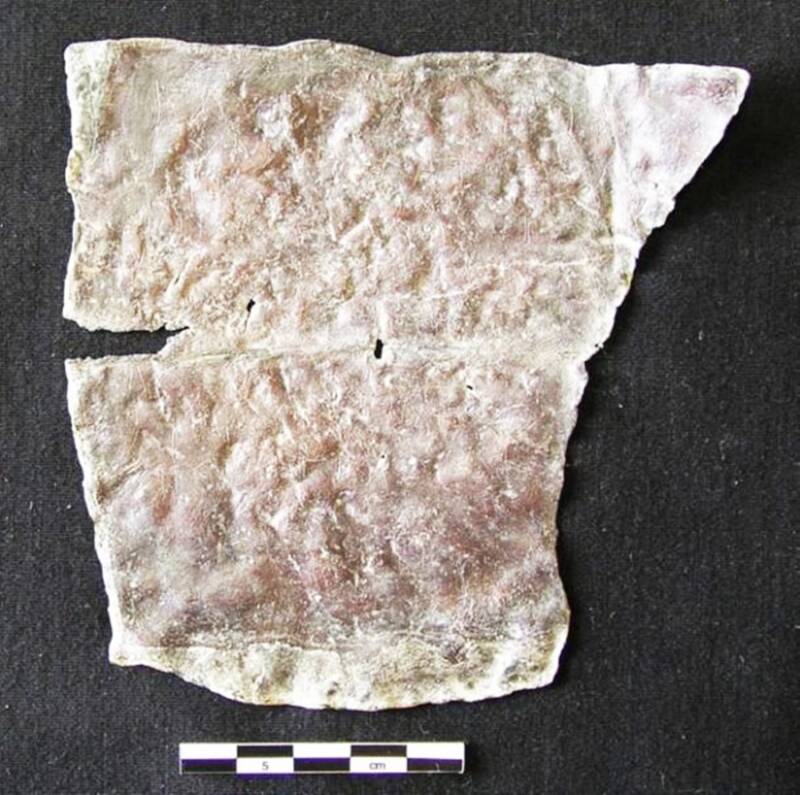
Jutta Stroszeck/German Archaeological InstituteTablet curse containing incantation against the newlywed Glykera, focusing on her vulva, by someone jealous of her marital bliss.
Have you ever wished ill on those you disliked, like a hex or a curse? You’re obviously not alone, but as it turns out, even the ancient Greeks dabbled in the dark arts.
Based on a recent discovery at the excavation site of Kerameikos, where the main graveyard of ancient Athens once stood, the Greeks inscribed lead tablets with curses meant to target their enemies both before and after they died.
As Haaretz reports, 30 such tablets were unearthed in a 38-foot, 2,500-year-old well that also contained other historical Greek artifacts, such as wine mixing vessels (krater), cooking pots, water-fetching clay pots, wooden artifacts, and more.
The most fascinating find from this trove, however, was no doubt the tablets. According to Jutta Stroszeck, director of the Kerameikos excavation under the German Archaeological Institute in Athens, these hex texts were an attempt to “invoke the gods of the underworld” to bring ill-will to whomever the curse was prescribed.
To read the tablets, scientists used a digital technique known as reflectance transformation imaging which makes even the tiniest inscriptions readable.

Jutta Stroszeck/German Archaeological InstituteA Grecian curse tablet in the shape of a liver found in Kerameikos where at least 30 such hexes have been discovered.
Based on ancient texts found in Cyprus in the 1930s, curses varied on whether the victim was living or dead. To curse a living enemy, one needed to place their hex tablet inside the tomb of a fresh corpse that died prematurely or under untimely circumstances. Such corpses included unmarried persons, casualties of war, or children.
The belief was that this corpse, unable to complete a “full life cycle,” could carry the curse from the living world to the underworld.
Such hexes from the Classical period (480-323 BC) have been discovered in tombs before but rarely inside a well. So why were these tablets found inside one?
It may have to do with a change in the law in ancient Athens.
Demetrios of Phaleron, who ruled over the city between 317 to 307 BCE, implemented a new law related to the management of tombs which explicitly banned residents from dumping their curses into people’s graves.
Greeks considered hexes and spells to be a part of the black arts and this law was likely meant to discourage people from practicing it. Instead, the law only forced those casting curses to become more creative in ensuring how their curse reached the underworld.
To the ancient Greeks, water was sacred and provided a direct connection to the underworld. But water was also believed to be protected by nymphs who “could become very mischievous when their water was treated badly,” according to Stroszeck.
To appease these nymphs then, the Greeks would also include offerings when dropping their hexes down the well, which is likely why archaeologists found so many other things with the tablets.
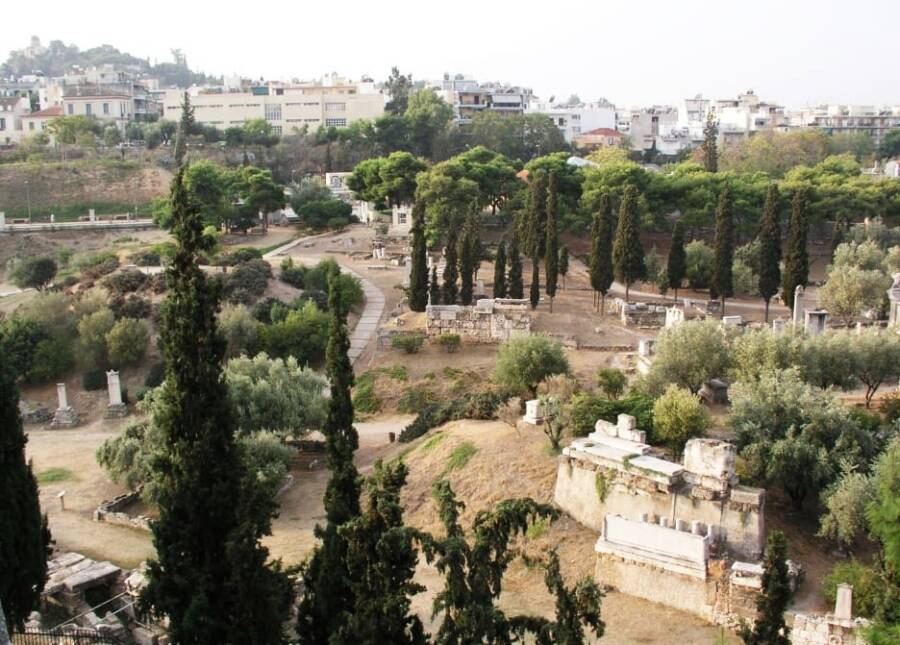
Jutta Stroszeck/German Archaeological InstituteThere have been more than 6,500 burials unearthed since excavations began in the necropolis of Kerameikos in 1913.
The ancient Greeks deployed curses for various reasons: money, opportunity, love, and hate. Curses were typically written by professional curse writers and were usually performed discreetly. Yet, there have been instances where people were hexed publicly.
The most notable example of this was the public cursing of General Alcibiades. Rumor spread that Alcibiades, in a drunken stupor, had broken the stone genitalia of the city’s Hermes stones which were considered religious items.
For his crime, Alcibiades was indicted with sacrilege and the priests and priestesses were compelled to hex him. After his possessions were confiscated, Alcibiades self-exiled to Sparta.
So far, there have been an estimated 6,500 burials uncovered at Kerameikos since excavations began in 1913. But the 2,500-year-old well full of curses wasn’t found until 2016.
The 30 curse tablets are currently under the examination of researchers.
Next, read how a Greek farmer accidentally discovered a 3,400-year-old Minoan tomb hidden under an olive grove. Then, learn about the five most important battles of the Ancient Greek wars.
By Natasha Ishak
These 30 "curse tablets" meant for the dead show what lengths Athenians would go to hex their enemies.

Jutta Stroszeck/German Archaeological InstituteTablet curse containing incantation against the newlywed Glykera, focusing on her vulva, by someone jealous of her marital bliss.
Have you ever wished ill on those you disliked, like a hex or a curse? You’re obviously not alone, but as it turns out, even the ancient Greeks dabbled in the dark arts.
Based on a recent discovery at the excavation site of Kerameikos, where the main graveyard of ancient Athens once stood, the Greeks inscribed lead tablets with curses meant to target their enemies both before and after they died.
As Haaretz reports, 30 such tablets were unearthed in a 38-foot, 2,500-year-old well that also contained other historical Greek artifacts, such as wine mixing vessels (krater), cooking pots, water-fetching clay pots, wooden artifacts, and more.
The most fascinating find from this trove, however, was no doubt the tablets. According to Jutta Stroszeck, director of the Kerameikos excavation under the German Archaeological Institute in Athens, these hex texts were an attempt to “invoke the gods of the underworld” to bring ill-will to whomever the curse was prescribed.
To read the tablets, scientists used a digital technique known as reflectance transformation imaging which makes even the tiniest inscriptions readable.

Jutta Stroszeck/German Archaeological InstituteA Grecian curse tablet in the shape of a liver found in Kerameikos where at least 30 such hexes have been discovered.
Based on ancient texts found in Cyprus in the 1930s, curses varied on whether the victim was living or dead. To curse a living enemy, one needed to place their hex tablet inside the tomb of a fresh corpse that died prematurely or under untimely circumstances. Such corpses included unmarried persons, casualties of war, or children.
The belief was that this corpse, unable to complete a “full life cycle,” could carry the curse from the living world to the underworld.
Such hexes from the Classical period (480-323 BC) have been discovered in tombs before but rarely inside a well. So why were these tablets found inside one?
It may have to do with a change in the law in ancient Athens.
Demetrios of Phaleron, who ruled over the city between 317 to 307 BCE, implemented a new law related to the management of tombs which explicitly banned residents from dumping their curses into people’s graves.
Greeks considered hexes and spells to be a part of the black arts and this law was likely meant to discourage people from practicing it. Instead, the law only forced those casting curses to become more creative in ensuring how their curse reached the underworld.
To the ancient Greeks, water was sacred and provided a direct connection to the underworld. But water was also believed to be protected by nymphs who “could become very mischievous when their water was treated badly,” according to Stroszeck.
To appease these nymphs then, the Greeks would also include offerings when dropping their hexes down the well, which is likely why archaeologists found so many other things with the tablets.

Jutta Stroszeck/German Archaeological InstituteThere have been more than 6,500 burials unearthed since excavations began in the necropolis of Kerameikos in 1913.
The ancient Greeks deployed curses for various reasons: money, opportunity, love, and hate. Curses were typically written by professional curse writers and were usually performed discreetly. Yet, there have been instances where people were hexed publicly.
The most notable example of this was the public cursing of General Alcibiades. Rumor spread that Alcibiades, in a drunken stupor, had broken the stone genitalia of the city’s Hermes stones which were considered religious items.
For his crime, Alcibiades was indicted with sacrilege and the priests and priestesses were compelled to hex him. After his possessions were confiscated, Alcibiades self-exiled to Sparta.
So far, there have been an estimated 6,500 burials uncovered at Kerameikos since excavations began in 1913. But the 2,500-year-old well full of curses wasn’t found until 2016.
The 30 curse tablets are currently under the examination of researchers.
Next, read how a Greek farmer accidentally discovered a 3,400-year-old Minoan tomb hidden under an olive grove. Then, learn about the five most important battles of the Ancient Greek wars.
Scientists Grow Trees From 2,000-Year-Old Seeds Found In Dead Sea Scroll Caves
By Natasha Ishak Published February 6, 2020
The newly grown plants — named Adam, Hannah, Uriel, Boaz, Jonah, and Judith — sprouted from ancient seeds sourced from historical sites in Israel.

By Natasha Ishak Published February 6, 2020
The newly grown plants — named Adam, Hannah, Uriel, Boaz, Jonah, and Judith — sprouted from ancient seeds sourced from historical sites in Israel.

PixabayJudean dates were ubiquitously grown in the region until the 19th century and famed for their long shelf life.
Who would have known that seeds from 2,000 years ago would still be able to grow into trees today? This was proven by a team of scientists who were able to grow multiple date palms in Israel by using ancient seeds harvested from historical sites in the Judean desert.
Who would have known that seeds from 2,000 years ago would still be able to grow into trees today? This was proven by a team of scientists who were able to grow multiple date palms in Israel by using ancient seeds harvested from historical sites in the Judean desert.
According to The Atlantic, the team’s research began in 2005, when they tried to germinate seeds from Masada, an ancient fortress in Israel. Radiocarbon dating of the seeds established that they were about 2,000 years old.
Led by Sarah Sallon, a doctor at Hadassah Medical Center, the team’s experiment was a success and they managed to grow their first plant out of these ancient seeds, a date palm tree they named Methuselah. The name refers to a figure in the Bible who lived until the age of 969.
Sallon admitted that she didn’t expect the experiment would work.
But it did. Fast forward to 2020, and Methuselah now has six contemporaries named Adam, Hannah, Uriel, Boaz, Jonah, and Judith. Similar to their botanic predecessor, all six date palm plants came from ancient seeds and were grown in recent years.

Led by Sarah Sallon, a doctor at Hadassah Medical Center, the team’s experiment was a success and they managed to grow their first plant out of these ancient seeds, a date palm tree they named Methuselah. The name refers to a figure in the Bible who lived until the age of 969.
Sallon admitted that she didn’t expect the experiment would work.
But it did. Fast forward to 2020, and Methuselah now has six contemporaries named Adam, Hannah, Uriel, Boaz, Jonah, and Judith. Similar to their botanic predecessor, all six date palm plants came from ancient seeds and were grown in recent years.

Sallon et al., SciAdv, 2020The newly sprouted date trees, all grown from 2,000-year-old seeds.
The success of the more recent plant-growing experiment was important to do so that the team could document the progress of the plant’s growth properly (which they failed to do the first time since they had low hopes of the ancient seeds being viable at all).
The second experiment was also important to prove that their first effort wasn’t just a fluke — which it clearly wasn’t. Their remarkable new study was published this week in the journal Science Advances.
For the team’s recent study, they collected seed specimens from the Hebrew University of Jerusalem, many of which were sourced from the region’s archeological sites.
Some of the seeds were more well-preserved than others and therefore better suited for the experiment. In total, the scientists planted 32 of the best-preserved seeds in a small kibbutz in southern Israel.
Elaine Solowey, a collaborator who grew the seeds in the kibbutz, soaked the old seeds in water and applied commercial plant hormones and fertilizer. Interestingly enough, the protocol for planting them wasn’t that much different from planting modern seeds.
Out of the 32 seeds that were planted, six of them blossomed into date palm trees. Five of the successful seeds came from either Masada or the Qumran Caves, where the famous Dead Sea Scrolls were discovered. The sixth seed came from caves at Wadi Makukh.

The success of the more recent plant-growing experiment was important to do so that the team could document the progress of the plant’s growth properly (which they failed to do the first time since they had low hopes of the ancient seeds being viable at all).
The second experiment was also important to prove that their first effort wasn’t just a fluke — which it clearly wasn’t. Their remarkable new study was published this week in the journal Science Advances.
For the team’s recent study, they collected seed specimens from the Hebrew University of Jerusalem, many of which were sourced from the region’s archeological sites.
Some of the seeds were more well-preserved than others and therefore better suited for the experiment. In total, the scientists planted 32 of the best-preserved seeds in a small kibbutz in southern Israel.
Elaine Solowey, a collaborator who grew the seeds in the kibbutz, soaked the old seeds in water and applied commercial plant hormones and fertilizer. Interestingly enough, the protocol for planting them wasn’t that much different from planting modern seeds.
Out of the 32 seeds that were planted, six of them blossomed into date palm trees. Five of the successful seeds came from either Masada or the Qumran Caves, where the famous Dead Sea Scrolls were discovered. The sixth seed came from caves at Wadi Makukh.

Wikimedia Commons
Methuselah, the first date palm tree germinated from ancient seeds in 2005.
“It’s quite remarkable this team of researchers managed to germinate seeds of that age,” said Oscar Alejandro Pérez-Escobar, who studies ancient dates at the Royal Botanic Gardens in Kew. “These ancient seeds might represent lost genetic diversity we don’t see anymore.”
There are a myriad of benefits from the result of this study. For one, it will enable modern scientists to better understand how Judean farmers cultivated the lands to grow these date palms, which were once plentiful in the area up until the 19th century.
The longevity of Judean dates was so well-known that the ancient Greek historian Herodotus raved about the fruit in his writing and gifted them to the Roman emperor every year.
There’s also untapped potential from exploring the genetic makeup of these plants that were born from ancient seedlings. Next, Sallon and her team plan to mate Methuselah’s pollen to Hannah, which is expected to grow flowers within the next two years. Sadly, their baby dates likely won’t resemble those that were farmed 2,000 years ago.
“It won’t be the typical Judean date, because dates that were grown at that time – just like dates that are grown today – are not grown from seeds that somebody puts in the earth,” Sallon explained. “They are grown from clones from very high-producing females.”
Well, at least their study might still be fruitful.
Next, read about the first plant grown on the far side of the moon by a Chinese space probe and learn the true story of a Brazilian couple who planted 2 million trees and created an entire new forest.

Natasha Ishak
Natasha Ishak is a staff writer at All That's Interesting.
“It’s quite remarkable this team of researchers managed to germinate seeds of that age,” said Oscar Alejandro Pérez-Escobar, who studies ancient dates at the Royal Botanic Gardens in Kew. “These ancient seeds might represent lost genetic diversity we don’t see anymore.”
There are a myriad of benefits from the result of this study. For one, it will enable modern scientists to better understand how Judean farmers cultivated the lands to grow these date palms, which were once plentiful in the area up until the 19th century.
The longevity of Judean dates was so well-known that the ancient Greek historian Herodotus raved about the fruit in his writing and gifted them to the Roman emperor every year.
There’s also untapped potential from exploring the genetic makeup of these plants that were born from ancient seedlings. Next, Sallon and her team plan to mate Methuselah’s pollen to Hannah, which is expected to grow flowers within the next two years. Sadly, their baby dates likely won’t resemble those that were farmed 2,000 years ago.
“It won’t be the typical Judean date, because dates that were grown at that time – just like dates that are grown today – are not grown from seeds that somebody puts in the earth,” Sallon explained. “They are grown from clones from very high-producing females.”
Well, at least their study might still be fruitful.
Next, read about the first plant grown on the far side of the moon by a Chinese space probe and learn the true story of a Brazilian couple who planted 2 million trees and created an entire new forest.

Natasha Ishak
Natasha Ishak is a staff writer at All That's Interesting.
UPDATED
Mexican Officials Discover Another Dead Body Linked To Its Famous Monarch Butterfly Sanctuary
By Natasha Ishak
Published February 3, 2020
"Something strange is happening, because they're finishing off all the activists, the people who are doing something for society."

Homero Gómez González
Butterfly conservationist Homero Gómez González, who was found dead two weeks ago in a well near El Rosario Monarch Butterfly Preserve.
Last week, police discovered the dead body of Homero Gómez González, a local politician and environmental conservationist, inside a well near the prominent Monarch Butterfly Biosphere Reserve where he worked in Mexico. The death shocked locals and fellow activists who are convinced that González’s death was no accident.
Now, a week later, another body connected to the butterfly reserve has been uncovered. The second body has been identified as that of Raúl Hernández Romero, a part-time tour guide who brought visiting tourists along the grounds of the sanctuary. Hernández Romero was last seen by his wife when he left for work on Monday. When Hernández Romero failed to return home after work, his wife reported him missing to the police.
Local authorities were already in the midst of searching for another missing person: Homero Gómez González, who had been missing for two weeks before his body was discovered last week in a well near the butterfly reserve. An autopsy of Gómez’s body found signs of torture, leading authorities to consider affixation by submersion — in other words, drowning — as a probable cause of death.
Gómez, who was head of the butterfly sanctuary’s management council, spent the majority of his career as an outspoken advocate against illegal logging in Mexico’s forest region of Michoacan, where millions of monarch butterflies migrate over 3,400 miles every winter from North America. The remarkable phenomenon turns the Mexican hillside into a haven for the orange-and-black butterflies and has long attracted biologists and tourists alike to the region.
En el Santuario El Rosario Ocampo Michoacan “ El más grande del mundo “ pic.twitter.com/WlCJuOcG4Q
— Homero gomez g. (@Homerogomez_g) January 12, 2020
Gómez, a former commissioner, and other community leaders promoted annual tourism spurred by the migratory butterflies as a sustainable revenue source for the community. He led demonstrations, marches, and local anti-logging patrols to keep the loggers at bay, and managed to push for the replanting of 370 acres which had previously been cleared to grow crops. In 2008, the Monarch Butterfly Biosphere Reserve was officially named a UNESCO World Heritage Site.
“It’s been a fight to maintain it,” Gómez had told the Washington Post just weeks before his death. “And it hasn’t been easy.”
Although officials have so far stated there has been no evidence of a conspiratorial murder, the discovery of Hernández Romero’s body, who is also connected to the butterfly sanctuary, has convinced many that their deaths are related to the growing clashes between conservationists and illegal loggers.
“Something strange is happening, because they’re finishing off all the activists, the people who are doing something for society,” Gómez’s brother, Amado Gomez, said during his funeral which was attended by hundreds of farmers and agricultural workers.
“I would like to ask the authorities to do their job and do more to protect activists like my brother, because lately in Mexico a lot of activists have died,” Gomez said. “With his death, not only my family lost a loved one; but the whole world, and the monarch butterfly and the forests lost, too.”
Meanwhile, Greenpeace Mexico issued a statement calling the deaths as outright “murder.”
“We condemn the fact that defending the land, natural resources and biodiversity converts activists into targets for threats, persecution and the cowardly act of taking their lives,” the group stated. Concern over the violence which environmentalists are often subjected to has become a larger concern for international organizations. In Mexico, there were 15 reported killings of environmental activists in 2017, and another 14 in 2018.
Swarm Of Butterflies

Homero Gómez/Twitter
Millions of monarch butterflies migrate to Mexico during the winter, spawning an unbelievable natural phenomenon.
Last year, according to a report by Amnesty International, there had been 12 murders in the first nine months alone. Mexican President Andrés Manuel López Obrador acknowledged the longstanding issue of violence against activists and described Gómez’s death as “regrettable” and “painful.”
“It’s part of what leads us to apply ourselves more every day to guarantee peace and tranquility in the country,” López Obrador said.
But it’s not just happening in Mexico. A study published last year in the journal Nature Sustainability found that the number of environmental activism-related homicides had increased worldwide with at least 1,558 people murdered in 50 countries in recent decades.
According to the paper, which looked at data compiled from the watchdog Global Witness, Comissão Pastoral da Terra (Pastoral Land Commission, Brazil), The Guardian newspaper in the U.K., and other sources, only 10 percent of these murder cases resulted in a conviction, compared to a 43 percent average conviction rate for global homicides.
“The toll is unbelievable,” said Nathalie Butt, the study’s co-author and a researcher at Australia’s University of Queensland. “Conflict over resources is the issue, but it is corruption that is the problem.” Researchers found government corruption to be the biggest factor that allowed these murders to occur without much repercussion.
As investigations into the murders of the two butterfly conservationists in Mexico move forward, let’s hope that those responsible are brought to justice before more environmental activists meet similar, horrific ends.
At famed Mexican butterfly reserve, second worker found dead
Alan Ortega

FILE PHOTO: Monarch butterflies cling to a plant at the Sierra Chincua butterfly sanctuary on a mountain in the Mexican state of Michoacan, Mexico November 29, 2019. REUTERS/Josue Gonzalez/File Photo
URUAPAN, Mexico (Reuters) - Mexican authorities said on Saturday they are investigating the possible murder of a tour guide working at a famous butterfly reserve in the western state of Michoacan, just two days after its former environmental activist was buried.
Raul Hernandez’s body was found in the area in the early hours of Saturday, with different parts beaten, and a head injury possibly caused by a sharp object, the state attorney general said.
Earlier this week, Mexicans in El Rosario mourned the death of activist Homero Gomez, who had fought for a decade to protect the monarch butterflies until his mysterious death. It is unclear whether the two cases are connected.
The sudden disappearance of such a high-profile campaigner had sparked an outcry in Mexico, an increasingly violent country where activists are routinely threatened, harmed or even killed as a result of their work.
Millions of the orange and black insects make a 2,000-mile (3,220-km) journey each year from Canada to winter in central Mexico’s warmer weather. However, they are facing new challenges linked to extreme weather and changing habitat.
Michoacan state is not only home to the country’s largest monarch butterfly reserve, a World Heritage Site, but also rival drug gangs who battle to control smuggling routes through often-arid terrain to the Pacific and the interior of the country.
Two monarch butterfly activists found dead in Mexico

Two activists at one of Mexico's largest monarch butterfly sanctuaries have been found dead within a week. Photo by Alianza-WWF-Telcel/EPA-EFE
Feb. 3 (UPI) -- Two monarch butterfly activists have been found dead in Mexico in less than a week, authorities have said.
Homero Gomez Gonzalez was found floating in a well with a head injury last week, while the body of Raul Hernandez Romero was found dead on Saturday with signs that he had been beaten with a sharp object.
Gomez Gonzalez, who managed the El Rosario monarch butterfly reserve was missing for two weeks before his body was found and Hernandez Romero, a part-time tour guide at the sanctuary, was last seen leaving his home in the municipality of Angangueo on Jan. 27.
Officials said they were unsure if the two deaths were linked or related to their work at the butterfly reserve.
Michoacan attorney general's office spokeswoman Magdalena Guzman said authorities were "looking into several lines of investigation" into their deaths.
Gomez Gonzalez, a former logger, spoke out against the illegal logging of timber in Mexico that threatens the habitats and livelihoods of the millions of buterflies that travel to the country from the United States and Canada each winter.
His death called attention to the dangers facing activists in Mexico, with many environmental activists having been killed after clashing with developers and local crime groups.
Mexican President Andres Manuel Lopez Obrador described Gomez Gonzalez's death as "very unfortunate and painful."
Mexican Officials Discover Another Dead Body Linked To Its Famous Monarch Butterfly Sanctuary
By Natasha Ishak
Published February 3, 2020
"Something strange is happening, because they're finishing off all the activists, the people who are doing something for society."

Homero Gómez González
Butterfly conservationist Homero Gómez González, who was found dead two weeks ago in a well near El Rosario Monarch Butterfly Preserve.
Last week, police discovered the dead body of Homero Gómez González, a local politician and environmental conservationist, inside a well near the prominent Monarch Butterfly Biosphere Reserve where he worked in Mexico. The death shocked locals and fellow activists who are convinced that González’s death was no accident.
Now, a week later, another body connected to the butterfly reserve has been uncovered. The second body has been identified as that of Raúl Hernández Romero, a part-time tour guide who brought visiting tourists along the grounds of the sanctuary. Hernández Romero was last seen by his wife when he left for work on Monday. When Hernández Romero failed to return home after work, his wife reported him missing to the police.
Local authorities were already in the midst of searching for another missing person: Homero Gómez González, who had been missing for two weeks before his body was discovered last week in a well near the butterfly reserve. An autopsy of Gómez’s body found signs of torture, leading authorities to consider affixation by submersion — in other words, drowning — as a probable cause of death.
Gómez, who was head of the butterfly sanctuary’s management council, spent the majority of his career as an outspoken advocate against illegal logging in Mexico’s forest region of Michoacan, where millions of monarch butterflies migrate over 3,400 miles every winter from North America. The remarkable phenomenon turns the Mexican hillside into a haven for the orange-and-black butterflies and has long attracted biologists and tourists alike to the region.
En el Santuario El Rosario Ocampo Michoacan “ El más grande del mundo “ pic.twitter.com/WlCJuOcG4Q
— Homero gomez g. (@Homerogomez_g) January 12, 2020
Gómez, a former commissioner, and other community leaders promoted annual tourism spurred by the migratory butterflies as a sustainable revenue source for the community. He led demonstrations, marches, and local anti-logging patrols to keep the loggers at bay, and managed to push for the replanting of 370 acres which had previously been cleared to grow crops. In 2008, the Monarch Butterfly Biosphere Reserve was officially named a UNESCO World Heritage Site.
“It’s been a fight to maintain it,” Gómez had told the Washington Post just weeks before his death. “And it hasn’t been easy.”
Although officials have so far stated there has been no evidence of a conspiratorial murder, the discovery of Hernández Romero’s body, who is also connected to the butterfly sanctuary, has convinced many that their deaths are related to the growing clashes between conservationists and illegal loggers.
“Something strange is happening, because they’re finishing off all the activists, the people who are doing something for society,” Gómez’s brother, Amado Gomez, said during his funeral which was attended by hundreds of farmers and agricultural workers.
“I would like to ask the authorities to do their job and do more to protect activists like my brother, because lately in Mexico a lot of activists have died,” Gomez said. “With his death, not only my family lost a loved one; but the whole world, and the monarch butterfly and the forests lost, too.”
Meanwhile, Greenpeace Mexico issued a statement calling the deaths as outright “murder.”
“We condemn the fact that defending the land, natural resources and biodiversity converts activists into targets for threats, persecution and the cowardly act of taking their lives,” the group stated. Concern over the violence which environmentalists are often subjected to has become a larger concern for international organizations. In Mexico, there were 15 reported killings of environmental activists in 2017, and another 14 in 2018.
Swarm Of Butterflies

Homero Gómez/Twitter
Millions of monarch butterflies migrate to Mexico during the winter, spawning an unbelievable natural phenomenon.
Last year, according to a report by Amnesty International, there had been 12 murders in the first nine months alone. Mexican President Andrés Manuel López Obrador acknowledged the longstanding issue of violence against activists and described Gómez’s death as “regrettable” and “painful.”
“It’s part of what leads us to apply ourselves more every day to guarantee peace and tranquility in the country,” López Obrador said.
But it’s not just happening in Mexico. A study published last year in the journal Nature Sustainability found that the number of environmental activism-related homicides had increased worldwide with at least 1,558 people murdered in 50 countries in recent decades.
According to the paper, which looked at data compiled from the watchdog Global Witness, Comissão Pastoral da Terra (Pastoral Land Commission, Brazil), The Guardian newspaper in the U.K., and other sources, only 10 percent of these murder cases resulted in a conviction, compared to a 43 percent average conviction rate for global homicides.
“The toll is unbelievable,” said Nathalie Butt, the study’s co-author and a researcher at Australia’s University of Queensland. “Conflict over resources is the issue, but it is corruption that is the problem.” Researchers found government corruption to be the biggest factor that allowed these murders to occur without much repercussion.
As investigations into the murders of the two butterfly conservationists in Mexico move forward, let’s hope that those responsible are brought to justice before more environmental activists meet similar, horrific ends.
At famed Mexican butterfly reserve, second worker found dead
Alan Ortega
FILE PHOTO: Monarch butterflies cling to a plant at the Sierra Chincua butterfly sanctuary on a mountain in the Mexican state of Michoacan, Mexico November 29, 2019. REUTERS/Josue Gonzalez/File Photo
URUAPAN, Mexico (Reuters) - Mexican authorities said on Saturday they are investigating the possible murder of a tour guide working at a famous butterfly reserve in the western state of Michoacan, just two days after its former environmental activist was buried.
Raul Hernandez’s body was found in the area in the early hours of Saturday, with different parts beaten, and a head injury possibly caused by a sharp object, the state attorney general said.
Earlier this week, Mexicans in El Rosario mourned the death of activist Homero Gomez, who had fought for a decade to protect the monarch butterflies until his mysterious death. It is unclear whether the two cases are connected.
The sudden disappearance of such a high-profile campaigner had sparked an outcry in Mexico, an increasingly violent country where activists are routinely threatened, harmed or even killed as a result of their work.
Millions of the orange and black insects make a 2,000-mile (3,220-km) journey each year from Canada to winter in central Mexico’s warmer weather. However, they are facing new challenges linked to extreme weather and changing habitat.
Michoacan state is not only home to the country’s largest monarch butterfly reserve, a World Heritage Site, but also rival drug gangs who battle to control smuggling routes through often-arid terrain to the Pacific and the interior of the country.
Two monarch butterfly activists found dead in Mexico

Two activists at one of Mexico's largest monarch butterfly sanctuaries have been found dead within a week. Photo by Alianza-WWF-Telcel/EPA-EFE
Feb. 3 (UPI) -- Two monarch butterfly activists have been found dead in Mexico in less than a week, authorities have said.
Homero Gomez Gonzalez was found floating in a well with a head injury last week, while the body of Raul Hernandez Romero was found dead on Saturday with signs that he had been beaten with a sharp object.
Gomez Gonzalez, who managed the El Rosario monarch butterfly reserve was missing for two weeks before his body was found and Hernandez Romero, a part-time tour guide at the sanctuary, was last seen leaving his home in the municipality of Angangueo on Jan. 27.
Officials said they were unsure if the two deaths were linked or related to their work at the butterfly reserve.
Michoacan attorney general's office spokeswoman Magdalena Guzman said authorities were "looking into several lines of investigation" into their deaths.
Gomez Gonzalez, a former logger, spoke out against the illegal logging of timber in Mexico that threatens the habitats and livelihoods of the millions of buterflies that travel to the country from the United States and Canada each winter.
His death called attention to the dangers facing activists in Mexico, with many environmental activists having been killed after clashing with developers and local crime groups.
Mexican President Andres Manuel Lopez Obrador described Gomez Gonzalez's death as "very unfortunate and painful."
---30---
Meet The Men Who Invented The Light Bulb Before Thomas Edison Got All The Credit
Meet The Men Who Invented The Light Bulb Before Thomas Edison Got All The Credit
The electrical measurement of “volt” was later named for Volta.
In 1806, English inventor Humphry Davy showed off the first electric arc lamp using a battery like Volta’s to produce a reliable current. These lamps generated light through open-air electrodes which ionized gas. But these lamps were also too difficult to use and burned too brightly and quickly for at-home usage, so they were employed primarily by cities in public areas. The arc lamp went on to become a commercial, albeit limited, success.
Scientists already knew that when enough electricity was passed through certain materials, they would heat up and if they got hot enough they would begin to glow. This process is called “incandescence.”
The problem with early incandescent bulbs, however, was that these materials would eventually become so hot that they’d burn up or melt. Incandescence could only become a practical, commercial success if the right material, called a filament, could be found to produce light without burning out too fast.
After a Scottish scientist named James Bowman Lindsay demonstrated in 1835 that constant electric light was even possible if the filament was made of copper, the next 40 years in light bulb research centered around finding the right materials for a filament and enclosing the filament in a gas-less space, like a vacuum, or a glass bulb, to keep it alight for as long as possible.
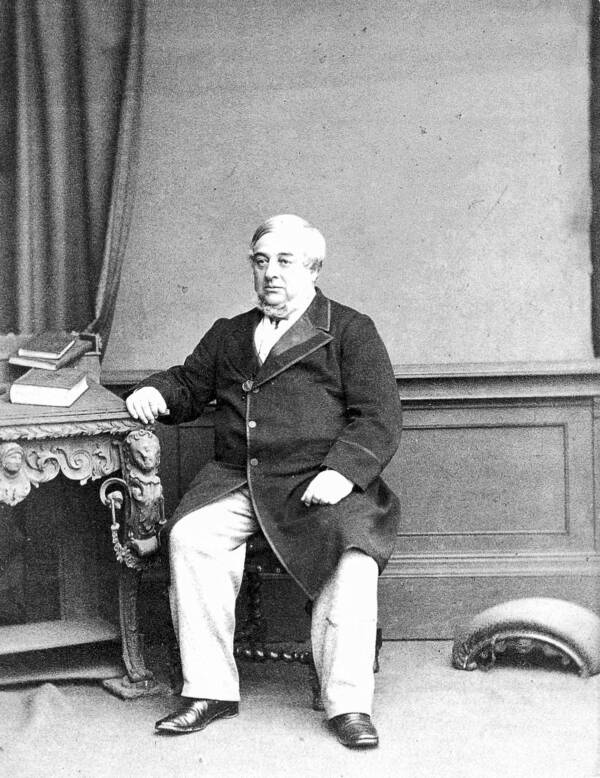
Wikimedia CommonsWarren de la Rue made a major breakthrough in the creation of the light bulb decades before Edison’s model was patented.
The next major breakthrough in developing a commercial light bulb occurred in 1840 by British inventor Warren de la Rue.
De la Rue figured that the best approach for a reliable, safe, and long-lasting electrical light was to use a platinum filament instead of a copper one fastened inside a vacuum tube.
De La Rue chose to use platinum as a filament because of its high melting point. Platinum could tolerate large amounts of electricity and glow without the threat of bursting into flame at high temperatures. He chose to fasten the filament inside a vacuum-sealed chamber because the fewer gas molecules that could react with the platinum, the longer its glow would last.
But platinum, then as now, was far too expensive to be manufactured commercially. Besides, vacuum-pumps were less efficient in de la Rue’s time, and so his model was not perfect.
The theory he employed for this light bulb largely seemed to work, however, and so experiments continued. Unfortunately, these early designs were stymied by cost or impracticality as some bulbs glowed too dim or required too much current to glow at all.

Wikimedia CommonsJoseph Swan was actually the first man in the world to have electric lamps installed in his home. Most of the components in his early 1879 model for the light bulb were taken by Edison and used in his model, which Edison then patented in 1880.
British physicist Joseph Swan had studied the problems with incandescent lighting beginning with cost-effectiveness as early as 1850.
At first, he used carbonized paper and cardboard as cheaper alternatives to metal filaments but found it too difficult to prevent these paper filaments from burning out quickly. He later patented a design using cotton threads as filaments in 1869 but this design suffered from the same problems to be of practical use.
The 1877 invention of the Sprengel air pump would change the game in light bulb development. The pump created better vacuums in glass bulbs which in turn prevented filaments from reacting to outside gasses and burning out too quickly.
Swan revisited his designs with this pump in mind and experimented with a variety of materials for the filament. In January 1879, he developed a light bulb that burned but did not burn out using a cotton filament dipped in acid and vacuum-sealed in a glass bulb.
He demonstrated the design the next month but found that after a short time, the bulb smoked, turned black, and was rendered useless. Swan’s failure was in his filament: it was too thick and required too much electricity to glow.
But Swan nonetheless continued to experiment.
So When Did Thomas Edison Invent His Light Bulb?
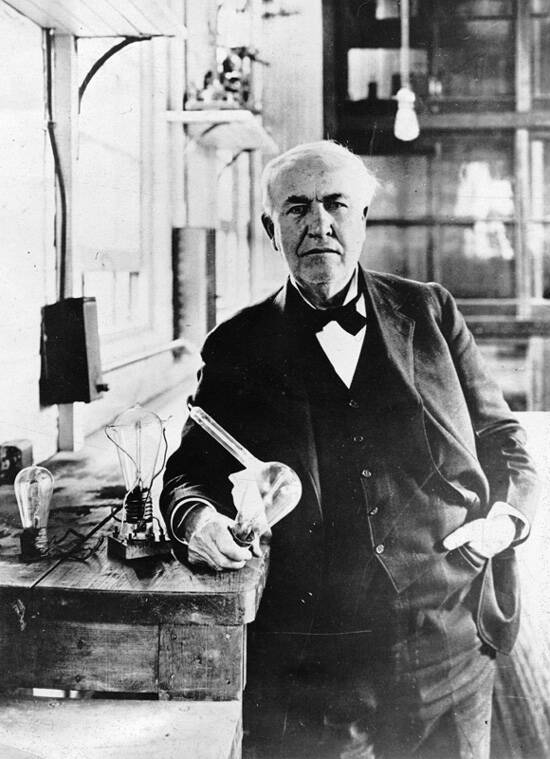
Wikimedia CommonsThomas Edison claimed to have tested over 6,000 different organic materials to find the perfect filament for his improvement on the incandescent light bulb.
Meanwhile, Thomas Alva Edison was working across the pond to solve the same problems. The 31-year old inventor had 169 patents by that time and had established a research facility in Menlo Park, New Jersey.
Edison wanted to make incandescent light bulbs both affordable and reliable, too. He studied his competition in this endeavor which naturally included Swan, and determined that a successful light bulb needed a thinner filament that did not require a large electrical current.
Edison himself worked up to 20 hours per day testing and experimenting with various designs and materials for filaments.
In October 1878, just one year after Swan’s failed attempt, Edison developed a light bulb with a platinum filament that burned for 40 minutes before burning out. It seemed that the so-called “Wizard of Menlo Park” was on the verge of inventing a practical light bulb, but it too suffered the same problems as its predecessors.
Anticipating success, Edison borrowed $300,000 to establish the Edison Electric Light Company with J.P. Morgan as one of its investors.
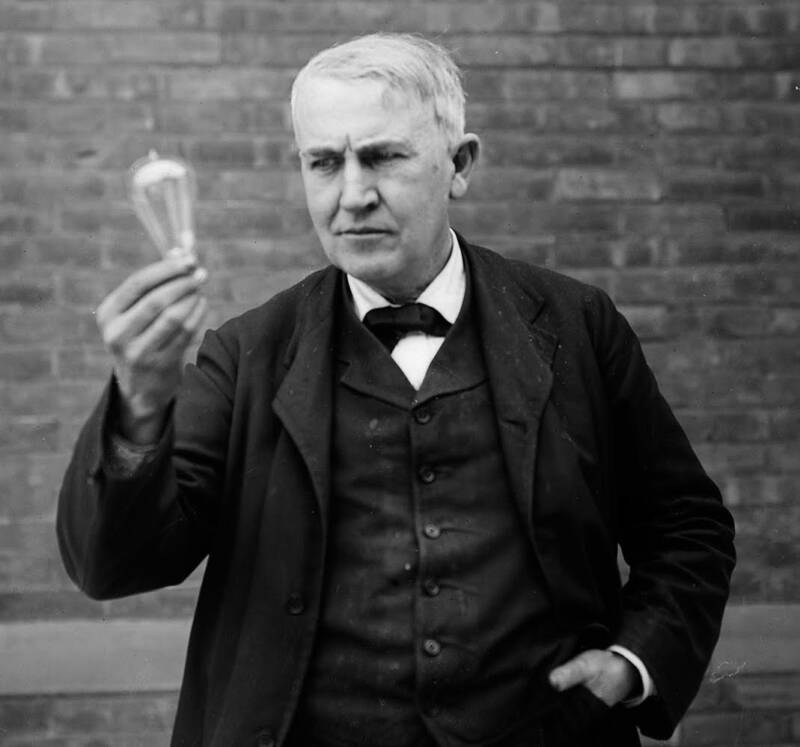
NPS Edison’s patented bulb contained many of the same elements as seen in Swan’s 1879 model.
Edison continued to test 300 different kinds of filaments in over 1,400 experiments. His team tested on seemingly any substance they could get their hands on including flax, cedar, and hickory. He even experimented on tungsten, which was common in later light bulbs. But Edison did not have the tools to work this material properly.
The Historic Break Through In Light Bulbs

Wikimedia CommonsA replica of the Menlo Park laboratory.
Then in October 1879, Edison settled on a thinner, higher-resistance cotton filament than the one Swan had used. He reasoned that the higher the resistance in the filament, the less electrical current would be required to make it glow. His 1879 design burned for 14.5 hours.
For his realization regarding high resistance, Edison is generally credited with having conceived of the first practical-use incandescent light bulb.
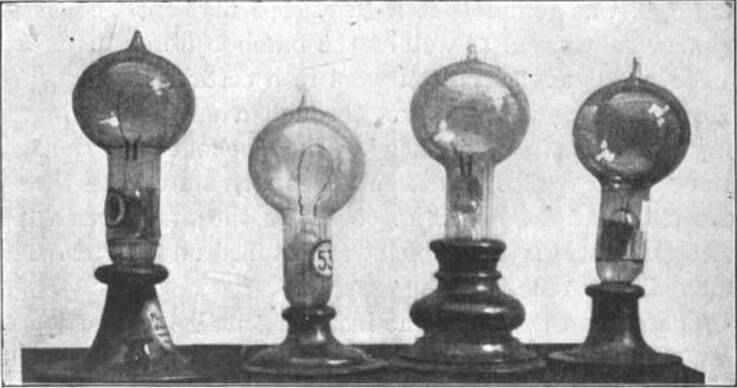
Wikimedia CommonsEdison’s incandescent light bulb is considered to be the first for commercial and practical application.
Edison’s team would later use a filament derived from bamboo that glowed for 1,200 hours. He received a patent for this “improved” practical incandescent bulb on Jan. 27, 1880.
Afterward, Menlo Park staff continued to tinker and improve the light bulb’s design. They developed better vacuum pumps and invented the socket screw that is common on most light bulbs today.
Most significantly, Edison developed the infrastructure needed to make incandescent lighting a vital part of society. Edison and his team developed electrical plants to power homes at large and power meters to measure its usage. General Electric was formed as the result of an 1892 merger with Edison’s company.
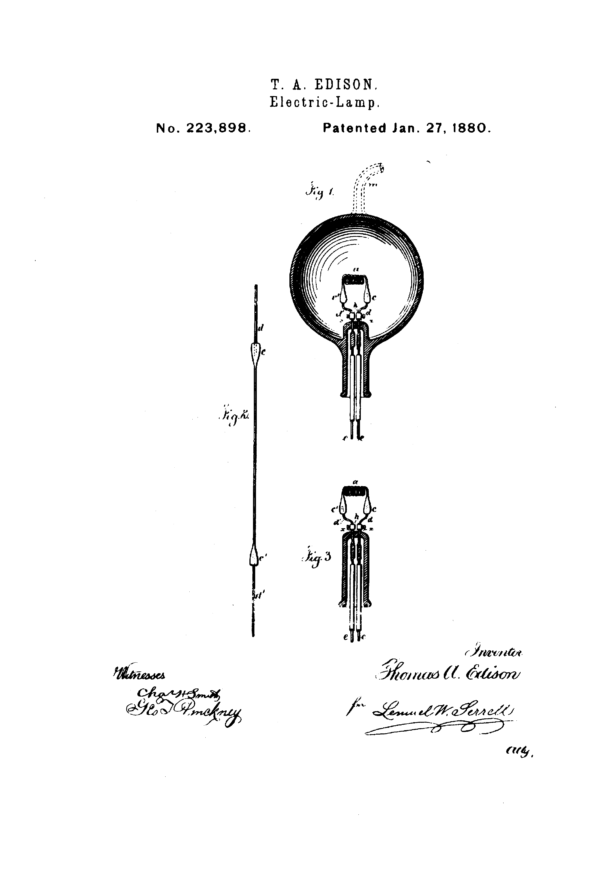
Wikimedia CommonsEdison’s design for a light bulb as issued on his official patent.
After Edison, electric light became available from Broadway to the bedroom.
Ediswan And Legacy
The same month that Edison developed his light bulb, Joseph Swan announced he had perfected his own and obtained a British patent for it on Nov. 27, 1880.
Swan’s home was the first in history to be lit with electric light and he also was responsible for lighting the Savoy Theater 1881. This was the first time a large public building was lit entirely by electricity and demonstrated the superiority of incandescent light over gas light.
Swan then established the Swan United Electric Light Company in 1881 and Edison sued for copyright infringement. The British courts ruled in Swan’s favor and Edison and Swan merged their companies into Ediswan which allowed them to dominate the U.K. market.
Because of the new business relationship, Swan was forced to support the validity of Edison’s patents so to the public, Edison and the light bulb became synonymous. Although he never escaped from Edison’s shadow, Joseph Swan was knighted for his achievements in 1904 and became a Fellow of the Royal Society.

Wikimedia CommonsA 19th-century poster for Ediswan.
In the end, it is Edison who is best remembered as the inventor of the light bulb, in part for his penchant for publicity and his determination to make the light bulb a common household item. Swan’s own reticence for self-promotion and the fact that he had to publicly support the validity of Edison’s patents also helped to bring Edison to the forefront of public consciousness.
Certainly, credit belongs to Edison as it was his design and his electrical infrastructure that set the tempo for the world’s light bulb as we know it today. At the same time, it ought to be recognized that Edison was but one among many inventors who worked to improve the light bulb.
Perhaps it is fair to say that Edison’s genius was not so much in his innovation, but rather in his ability to apply practicality to inventions that otherwise may have just stayed in the laboratory.
Now that you’ve learned who invented the light bulb, check out this article on six famous inventors who didn’t get the credit they deserved. Then, read this article on some of the eccentricities of the inventor Nikola Tesla.
PATENTS ARE NOT INVENTIONS PATENTS ARE THEFT
INTELLECTUAL PROPERTY IS THEFT
By Joseph Williams Published February 6, 2020
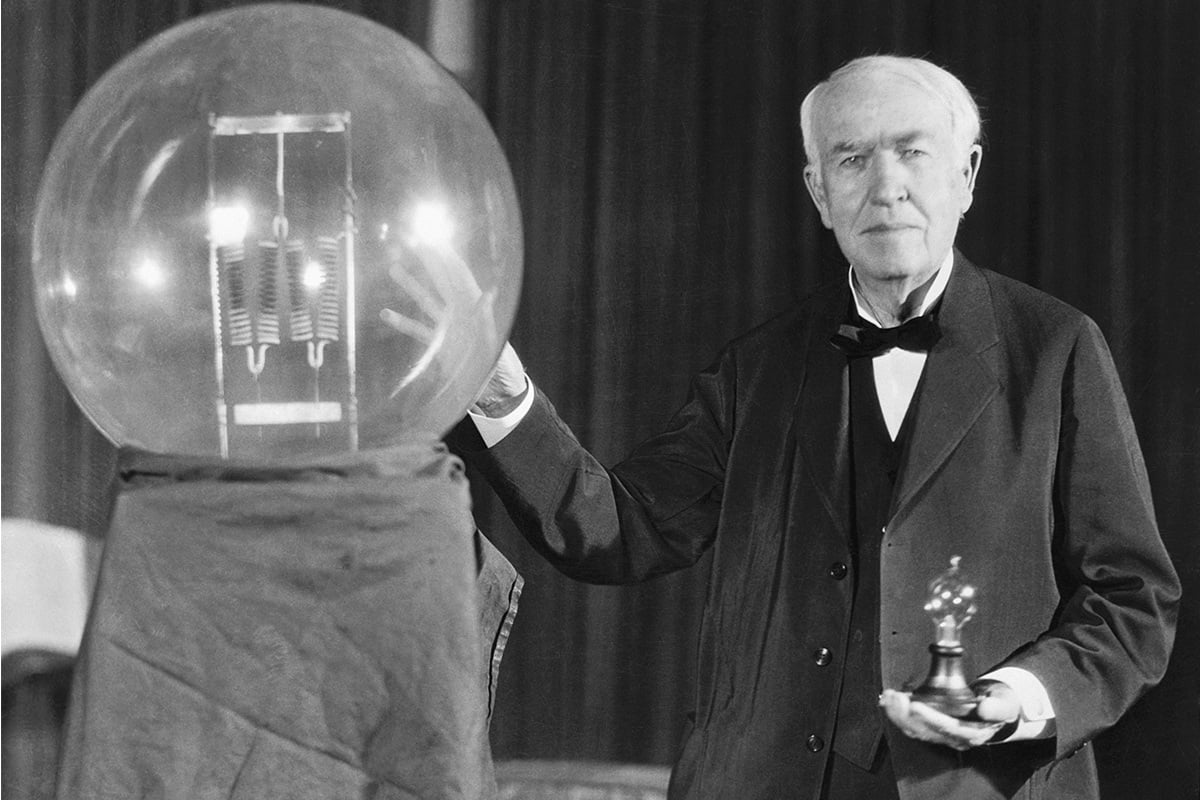
Nearly 80 years before Edison got his patent, these largely-forgotten scientists created the first light bulbs — so why haven't you heard of them?Of Thomas Edison’s 1,000 patents, the very first light bulb is not one of them.
Indeed, Edison’s patent for the light bulb was referred to as “an improvement” on existing models. In order to create a more practical, efficient, and affordable model of electric lamps, records show that the engineer purchased patents from previous inventors.
Determining when the light bulb was first invented is, therefore, a nuanced question and one that requires we acknowledge researchers and scientists working long before and at the same time as Edison.
So who invented the light bulb, really?
The Minds Who Helped Invent The First Light Bulb
Throughout the 19th century, inventors searched for a safer and more convenient method of producing light to replace open flames or gaslighting. Electricity became the favorite alternative.

Wikimedia commonsPeople watch the cumbersome process of changing the electrodes in a 19th-century electric arc lamp, one of the predesecors for the first light bulbs.
One of the first devices to provide a reliable source of electricity was invented by the Italian inventor Alessandro Volta in 1800. The so-called “voltaic pile” was a primitive battery that employed copper, zinc, cardboard, and saltwater and when engaged with copper wire at either end conducted electricity.
By Joseph Williams Published February 6, 2020

Nearly 80 years before Edison got his patent, these largely-forgotten scientists created the first light bulbs — so why haven't you heard of them?Of Thomas Edison’s 1,000 patents, the very first light bulb is not one of them.
Indeed, Edison’s patent for the light bulb was referred to as “an improvement” on existing models. In order to create a more practical, efficient, and affordable model of electric lamps, records show that the engineer purchased patents from previous inventors.
Determining when the light bulb was first invented is, therefore, a nuanced question and one that requires we acknowledge researchers and scientists working long before and at the same time as Edison.
So who invented the light bulb, really?
The Minds Who Helped Invent The First Light Bulb
Throughout the 19th century, inventors searched for a safer and more convenient method of producing light to replace open flames or gaslighting. Electricity became the favorite alternative.

Wikimedia commonsPeople watch the cumbersome process of changing the electrodes in a 19th-century electric arc lamp, one of the predesecors for the first light bulbs.
One of the first devices to provide a reliable source of electricity was invented by the Italian inventor Alessandro Volta in 1800. The so-called “voltaic pile” was a primitive battery that employed copper, zinc, cardboard, and saltwater and when engaged with copper wire at either end conducted electricity.
The electrical measurement of “volt” was later named for Volta.
In 1806, English inventor Humphry Davy showed off the first electric arc lamp using a battery like Volta’s to produce a reliable current. These lamps generated light through open-air electrodes which ionized gas. But these lamps were also too difficult to use and burned too brightly and quickly for at-home usage, so they were employed primarily by cities in public areas. The arc lamp went on to become a commercial, albeit limited, success.
Scientists already knew that when enough electricity was passed through certain materials, they would heat up and if they got hot enough they would begin to glow. This process is called “incandescence.”
The problem with early incandescent bulbs, however, was that these materials would eventually become so hot that they’d burn up or melt. Incandescence could only become a practical, commercial success if the right material, called a filament, could be found to produce light without burning out too fast.
After a Scottish scientist named James Bowman Lindsay demonstrated in 1835 that constant electric light was even possible if the filament was made of copper, the next 40 years in light bulb research centered around finding the right materials for a filament and enclosing the filament in a gas-less space, like a vacuum, or a glass bulb, to keep it alight for as long as possible.

Wikimedia CommonsWarren de la Rue made a major breakthrough in the creation of the light bulb decades before Edison’s model was patented.
The next major breakthrough in developing a commercial light bulb occurred in 1840 by British inventor Warren de la Rue.
De la Rue figured that the best approach for a reliable, safe, and long-lasting electrical light was to use a platinum filament instead of a copper one fastened inside a vacuum tube.
De La Rue chose to use platinum as a filament because of its high melting point. Platinum could tolerate large amounts of electricity and glow without the threat of bursting into flame at high temperatures. He chose to fasten the filament inside a vacuum-sealed chamber because the fewer gas molecules that could react with the platinum, the longer its glow would last.
But platinum, then as now, was far too expensive to be manufactured commercially. Besides, vacuum-pumps were less efficient in de la Rue’s time, and so his model was not perfect.
The theory he employed for this light bulb largely seemed to work, however, and so experiments continued. Unfortunately, these early designs were stymied by cost or impracticality as some bulbs glowed too dim or required too much current to glow at all.
How Joseph Swan Helped Create The Light Bulb As We Know It

Wikimedia CommonsJoseph Swan was actually the first man in the world to have electric lamps installed in his home. Most of the components in his early 1879 model for the light bulb were taken by Edison and used in his model, which Edison then patented in 1880.
British physicist Joseph Swan had studied the problems with incandescent lighting beginning with cost-effectiveness as early as 1850.
At first, he used carbonized paper and cardboard as cheaper alternatives to metal filaments but found it too difficult to prevent these paper filaments from burning out quickly. He later patented a design using cotton threads as filaments in 1869 but this design suffered from the same problems to be of practical use.
The 1877 invention of the Sprengel air pump would change the game in light bulb development. The pump created better vacuums in glass bulbs which in turn prevented filaments from reacting to outside gasses and burning out too quickly.
Swan revisited his designs with this pump in mind and experimented with a variety of materials for the filament. In January 1879, he developed a light bulb that burned but did not burn out using a cotton filament dipped in acid and vacuum-sealed in a glass bulb.
He demonstrated the design the next month but found that after a short time, the bulb smoked, turned black, and was rendered useless. Swan’s failure was in his filament: it was too thick and required too much electricity to glow.
But Swan nonetheless continued to experiment.
So When Did Thomas Edison Invent His Light Bulb?

Wikimedia CommonsThomas Edison claimed to have tested over 6,000 different organic materials to find the perfect filament for his improvement on the incandescent light bulb.
Meanwhile, Thomas Alva Edison was working across the pond to solve the same problems. The 31-year old inventor had 169 patents by that time and had established a research facility in Menlo Park, New Jersey.
Edison wanted to make incandescent light bulbs both affordable and reliable, too. He studied his competition in this endeavor which naturally included Swan, and determined that a successful light bulb needed a thinner filament that did not require a large electrical current.
Edison himself worked up to 20 hours per day testing and experimenting with various designs and materials for filaments.
In October 1878, just one year after Swan’s failed attempt, Edison developed a light bulb with a platinum filament that burned for 40 minutes before burning out. It seemed that the so-called “Wizard of Menlo Park” was on the verge of inventing a practical light bulb, but it too suffered the same problems as its predecessors.
Anticipating success, Edison borrowed $300,000 to establish the Edison Electric Light Company with J.P. Morgan as one of its investors.

NPS Edison’s patented bulb contained many of the same elements as seen in Swan’s 1879 model.
Edison continued to test 300 different kinds of filaments in over 1,400 experiments. His team tested on seemingly any substance they could get their hands on including flax, cedar, and hickory. He even experimented on tungsten, which was common in later light bulbs. But Edison did not have the tools to work this material properly.
The Historic Break Through In Light Bulbs

Wikimedia CommonsA replica of the Menlo Park laboratory.
Then in October 1879, Edison settled on a thinner, higher-resistance cotton filament than the one Swan had used. He reasoned that the higher the resistance in the filament, the less electrical current would be required to make it glow. His 1879 design burned for 14.5 hours.
For his realization regarding high resistance, Edison is generally credited with having conceived of the first practical-use incandescent light bulb.

Wikimedia CommonsEdison’s incandescent light bulb is considered to be the first for commercial and practical application.
Edison’s team would later use a filament derived from bamboo that glowed for 1,200 hours. He received a patent for this “improved” practical incandescent bulb on Jan. 27, 1880.
Afterward, Menlo Park staff continued to tinker and improve the light bulb’s design. They developed better vacuum pumps and invented the socket screw that is common on most light bulbs today.
Most significantly, Edison developed the infrastructure needed to make incandescent lighting a vital part of society. Edison and his team developed electrical plants to power homes at large and power meters to measure its usage. General Electric was formed as the result of an 1892 merger with Edison’s company.

Wikimedia CommonsEdison’s design for a light bulb as issued on his official patent.
After Edison, electric light became available from Broadway to the bedroom.
Ediswan And Legacy
The same month that Edison developed his light bulb, Joseph Swan announced he had perfected his own and obtained a British patent for it on Nov. 27, 1880.
Swan’s home was the first in history to be lit with electric light and he also was responsible for lighting the Savoy Theater 1881. This was the first time a large public building was lit entirely by electricity and demonstrated the superiority of incandescent light over gas light.
Swan then established the Swan United Electric Light Company in 1881 and Edison sued for copyright infringement. The British courts ruled in Swan’s favor and Edison and Swan merged their companies into Ediswan which allowed them to dominate the U.K. market.
Because of the new business relationship, Swan was forced to support the validity of Edison’s patents so to the public, Edison and the light bulb became synonymous. Although he never escaped from Edison’s shadow, Joseph Swan was knighted for his achievements in 1904 and became a Fellow of the Royal Society.

Wikimedia CommonsA 19th-century poster for Ediswan.
In the end, it is Edison who is best remembered as the inventor of the light bulb, in part for his penchant for publicity and his determination to make the light bulb a common household item. Swan’s own reticence for self-promotion and the fact that he had to publicly support the validity of Edison’s patents also helped to bring Edison to the forefront of public consciousness.
Certainly, credit belongs to Edison as it was his design and his electrical infrastructure that set the tempo for the world’s light bulb as we know it today. At the same time, it ought to be recognized that Edison was but one among many inventors who worked to improve the light bulb.
Perhaps it is fair to say that Edison’s genius was not so much in his innovation, but rather in his ability to apply practicality to inventions that otherwise may have just stayed in the laboratory.
Now that you’ve learned who invented the light bulb, check out this article on six famous inventors who didn’t get the credit they deserved. Then, read this article on some of the eccentricities of the inventor Nikola Tesla.
The sun is still a burning mystery. That may be about to change.

The sun is still a burning mystery. That may be about to change.
Nadia Drake
On Sunday evening, a rocket is scheduled to streak through Florida’s nighttime sky, ferrying a spacecraft on a first-of-its-kind adventure to the sun.

© Illustration by ESA/ATG medialab
An illustration shows the ESA Solar Orbiter facing the sun during its closest approach to the star.
Even though our home star smolders every day in our skies, humans have only ever seen the sun from one perspective: face-on, from within the plane of the planets. The European Space Agency’s Solar Orbiter, or SolO, is about to change that, as it is designed to perform a detailed reconnaissance of the sun that will allow it to see the star’s previously invisible polar regions.

© Image by NSO/NSF/AURA
This image from the Daniel K. Inouye Solar Telescope released in February 2020 is the highest resolution image of the sun’s surface ever taken. It shows the huge cell-like structures created by the violent motions as heat from inside the star is transported upward.
From this unique vantage point, SolO’s suite of 10 instruments will help uncover how the star sends streams of energetic particles called the solar wind throughout our planetary system. It will also help answer what controls the sun’s 11-year magnetic cycle, which varies in intensity and creates unanticipated fluctuations in solar activity.
“We fundamentally really don’t understand that,” says ESA’s Daniel Müller, SolO project scientist. “Hopefully, we’re filling in that gap with Solar Orbiter.”
Untangling these drivers isn’t simply an academic matter; it can improve public safety on Earth. Changes in the sun’s magnetic activity factor into the powerful, energetic solar eruptions that can knock out power grids, bring down satellites, and prove lethal to humans in outer space. Right now, humans are not so good at predicting when or how strongly those eruptions will affect the planet.
“Understanding these fundamental processes, the physical processes taking place in the inner region of the solar atmosphere, is really going to help us,” says Holly Gilbert, NASA’s deputy project scientist for SolO.
SolO is launching during an especially hot moment in solar monitoring; it’s just one of several new projects set on staring at the sun, offering opportunities for even more robust scientific exploration of our home star.
“It is just a really good time to be a heliophysicist,” says Nicola Fox, NASA’s heliophysics division director. “Having this sort of coordinated push makes huge, huge changes in the amount of science you can do.”
Golden era for sun study
You may have noticed the sun is very hip right now.
Last week, the ground-based Daniel K. Inouye Solar Telescope, or DKIST, released a mesmerizing close-up of the solar surface. In movie form, those images reveal the sun’s skin to be a slowly bubbling, patchworked surface, with plasma cells the size of Texas.
And in December, NASA’s Parker Solar Probe released the first of its observations, collected while orbiting extremely close to the sun. This week, a special issue of The Astrophysical Journal unveiled four dozen additional studies about the mission. Among the trove are the first observations of “rogue” magnetic waves, the first hint of a dust-free environment immediately around the sun, the first glimpse of a pristine ejection of particles, and that stunning finding that the solar wind is speeding sideways much, much faster than expected, which can dramatically affect stellar evolution.
Parker Solar Probe is making these observations as it dives into the sun’s corona, an enigmatic sheath of superhot, million-degree gas and particles. Over its seven-year journey, it will swing closer and closer to the sun during each orbit, eventually coming within four million miles of our star’s blazing surface.
The Parker Solar Probe will be able to partner with the new SolO spacecraft, though the latter won’t come as close to the sun.
After SolO launches, it will swing by Earth and Venus, gathering gravitational assists from the planets that will sling it closer to the sun. Over the next five years, Venus’s gravity will propel the probe into an inclined orbit that will bring the solar poles into view, with the first glimpse of the poles expected in 2025.
“Each orbit will get higher and higher, so in a way we’re kind of unwrapping the polar regions, bit by bit,” Gilbert says.
Together, the spacecraft pair will assemble high-resolution observations of what could be the most dynamic, extreme environment in the solar system. Circling the sun in tandem, the two spacecraft will watch how the pristine solar wind, or the particles exhaled endlessly by the sun, evolves as it blusters into the solar system. And SolO comes with an onboard camera that can snap images of the sites Parker Solar Probe is flying through.
“It will be a really great synergy,” Gilbert says. “It’ll give us that contextual info, and then Parker will be there, measuring the actual plasma as [the SolO] orbiter images it.”
As the two orbiters buzz the sun, DKIST—from its Hawaiian perch atop Haleakalā on Maui—will see the solar surface in more detail than either of the farther-flung spacecraft. That’s partly because of its 13-foot mirror, which is far larger than even the Hubble Space Telescope’s.
“The things DKIST can do, we could never do from space,” Müller says. “It has unprecedented resolution in the visible part of the spectrum.”
It’s no coincidence that the sun is finally getting its day to shine, says Kelly Korreck, a heliophysicist at the Harvard-Smithsonian Center for Astrophysics, and one of the principal investigators for an instrument aboard the Parker Solar Probe. These new observatories, both ground- and space-based, culminate decades of planning and technological development, without which such explorations would have been impossible.
“The technology has caught up,” Korreck says, “and we can now do some of these daring, cool missions.”
SolO’s signature science
Meanwhile, SolO’s polar observations could add a crucial, missing piece to the puzzle of the sun’s magnetic cycle. For years, scientists have known that the sun’s activity ebbs and flows over an 11-year period—but theories describing how that works have never been able to match physical observations. One reason for those surprises, Müller says, is that detailed data on the solar polar regions were missing. In the mid-1990s and early 2000s, the Ulysses spacecraft did get a glimpse of the sun’s poles, although from very far away and without an onboard camera.
“We simply don’t know what the poles look like, and we really think we need that data to unravel some of the mysteries of the magnetic cycle,” Müller says. “That’s really been our blind spot.”
With a more comprehensive, global view, scientists should be able to really drill down into the intricacies of those magnetic cycles and the way that energy manifests on the star’s surface. Magnetic loops and waves have the potential to be extremely powerful, with newly discovered “rogue waves” perhaps explaining the mystery of why the corona is hotter than the sun’s surface.
Loops, which arch high above the sun’s surface, are often the sites where solar flares are born. Occasionally, those flares sling supersonic, super-charged blobs of particles into space, called coronal mass ejections, or CMEs. If one of those gusts careens toward Earth, it could be catastrophic.
In 1859, a particularly powerful CME knocked out telegraphs and set Earth’s skies ablaze with auroras so bright they mimicked daylight. Now called the Carrington Event, these types of space weather occurrences are exactly what scientists are hoping to predict as far ahead of time as possible.
With enough warning, vulnerable satellites and power grids could be proactively taken offline, and any humans who happened to be either in orbit or in deep space could take cover.
“We can mitigate that, but we really need to understand when the sun is going to be active, and how that’s going to interact with the Earth’s magnetosphere,” Korreck says. “As we get more and more dependent on satellites for communication, and go to the moon and Mars and become a spacefaring people, we really have to understand the dangers to crew as well as our own electronic assets in space.”
Plus, a more intimate grasp of how the sun works can help inform the prospects for life on planets orbiting sun-like stars.
“The other thing for me that’s really cool about it is just simply: It is a star,” Fox says. “We’re learning about how a star works. And that has applications for other stars in other stellar systems.”

Journey to the Far Side of the Sun (1969) - Rotten Tomatoes
https://www.rottentomatoes.com › journey_to_the_far_side_of_the_sun
Oct 10, 2000 - An American astronaut is selected to lead a British crew to a journey to another planet, hence the title. Colonel Glenn Ross ... Journey to the Far Side of the Sun ... Written By: Gerry Anderson, James Donald, Sylvia Anderson.
Journey to the Far Side of the Sun | Moviepedia | Fandom
https://movies.fandom.com › wiki › Journey_to_the_Far_Side_of_the_Sun
Journey to the Far Side of the Sun (also known as Doppelgänger) was a 1969 Science ... The film was produced by Gerry Anderson, who was best known for ...

Scientists Find Radiation-Eating Fungi At Chernobyl — And Now Seek To Harness Their Power
By Natasha Ishak
Published February 7, 2020
Scientists hope to use the fungi's abilities for those routinely exposed to radiation, like cancer patients, nuclear power plant engineers, and astronauts.
Abandoned Chernobyl Box Office

Getty Images
Since the Chernobyl nuclear explosion in 1986, species of fungi have been thriving off the radiation in these now-abandoned areas.
Whether it’s an asteroid or an ice age, planet Earth and its lifeforms always seem to find a way to carry on. Recently, scientists found that a few particularly impressive little lifeforms were even able to survive in an environment as harsh as Chernobyl.
The 1986 Chernobyl nuclear disaster remains the worst such incident in recorded history and has killed thousands over the years. Even decades later, radiation in Chernobyl’s surrounding area lingers, but this hot spot has also become a mecca for a certain type of fungi.
According to Popular Mechanics, scientists discovered at least 200 species and 98 genera of fungi thriving off radiation at the infamous disaster site. The astounding discovery was first documented in 1991 when scientists found fungi growing on the walls of the abandoned nuclear reactor which was still covered in gamma radiation.
Stunned, researchers began studying the organisms, known as “black fungi” due to their concentrations of melanin, and found that three different species were living off of the gamma radiation. These strains, Cladosporium sphaerospermum, Cryptococcus neoformans, and Wangiella dermatitidis, were even all found to grow faster in the presence of the radiation and even grow toward it as if naturally drawn to it.
Black Fungus Being Tested

NASA/JPL/CALTECH
Strain of black fungi being tested in the lab.
“The fungi collected at the accident site had more melanin than the fungi collected from outside the exclusion zone,” Kasthuri Venkat, a senior researcher at NASA and the lead scientist on the agency’s space fungi project, told Vice.
“This means the fungi have adapted to the radiation activity and as many as twenty percent were found to be radiotrophic—meaning they grew towards the radiation; they loved it.”
Because the fungi contain so much melanin, they are able to feed off the gamma rays and convert them into chemical energy, kind of like a darker version of photosynthesis. This process is called radiosynthesis.
“The presumption has always been that we don’t know why truffles and other fungi are black,” explained Arturo Casadevall, a microbiologist and co-author of the previous study. “If they have some primitive capacity to harvest sunlight or to harvest some kind of background radiation a lot of them would be using it.”
Chernobyl Disaster Workers Preparing For Cleanup IGOR KOSTIN, SYGMA/CORBIS “Liquidators” at the sight of the Chernobyl disaster preparing for cleanup, 1986.

This has led scientists to wonder whether the melanin in human skin cells could turn radiation into “food” too, but for now, they believe this is a stretch. However, they not ruling this possibility out for other lifeforms.
“The fact that it occurs in fungi raises the possibility that the same may occur in animals and plants,” Casadevall added. Scientists have thus been working to extract the radiation-absorbing power of Chernobyl’s fungi for the good of humankind in a number of ways.
One of these ways would be finding an application for the fungi’s capabilities in protecting those routinely exposed to radiation, like cancer patients and nuclear power plant engineers. Scientists also hope that the fungi could be used to develop a biological source of energy via radiation conversion.

Aerial View Of Reactor 4 In 1986 SHONE/GAMMA/Gamma-Rapho via Getty Images
View of the Chernobyl nuclear power plant after the explosion. April 26, 1986.
Meanwhile, another proposed application for the powers of these fungi lies in space travel.
In 2016, SpaceX and NASA sent a package to the International Space Station (ISS) containing several strains of fungi from Chernobyl. The shipment also included more than 250 different tests for the space crew to carry out.
Why space? The molecular changes that researchers observed in the Chernobyl fungi were brought on by the stress created from exposure to the site’s radiation. Researchers hoped to replicate this reaction in space, where they planned to expose the fungi to the stresses of microgravity and compare them with similar strains of fungi from Earth.
The results of the NASA study could have great benefits for future space travel, possibly allowing astronauts a way to protect themselves from deadly amounts of cosmic radiation. Findings from these investigations aboard the ISS will soon be published in an upcoming paper.
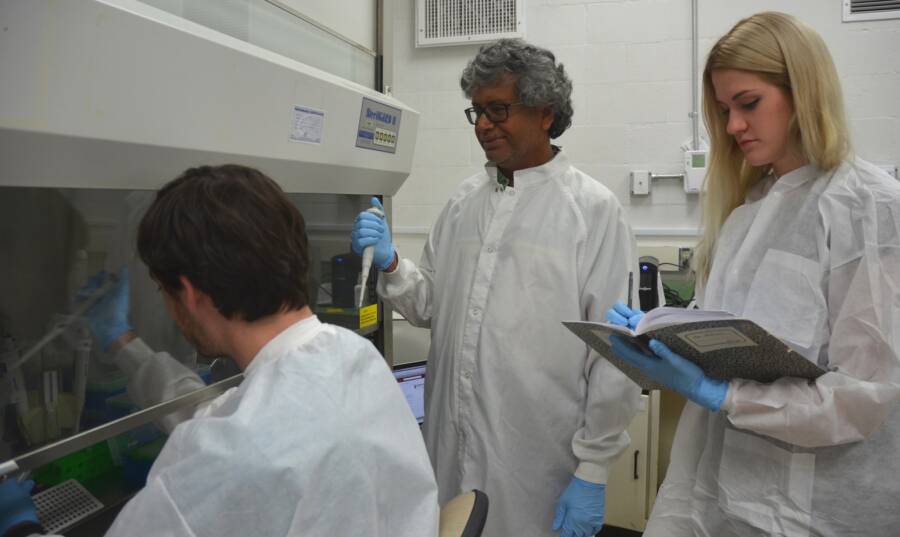
Scientists In Lab NASA/JPL/CALTECH Kasthuri Venkateswaran and interns examining radiation-eating fungi.
It’s not just fungi that have been able to flourish so effectively despite the radiation. Over the years, scientists have found an abundance of wildlife thriving in Chernobyl’s former Red Zone and at the site of the Fukushima nuclear disaster in Japan.
In Chernobyl and across Earth’s most dangerous zones of radioactivity, life keeps finding a way to adapt to even the harshest of environments.
Next, take a look at haunting photos of Chernobyl today after being frozen in time by the nuclear meltdown and read about Anatoly Dyatlov, the man behind the Chernobyl disaster.
Subscribe to:
Posts (Atom)